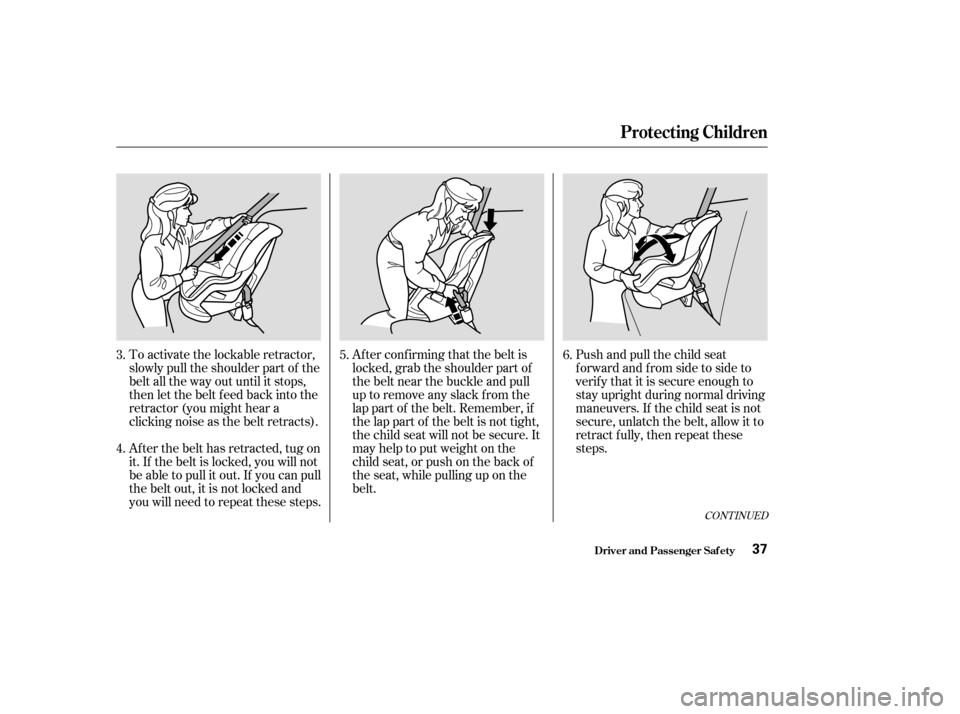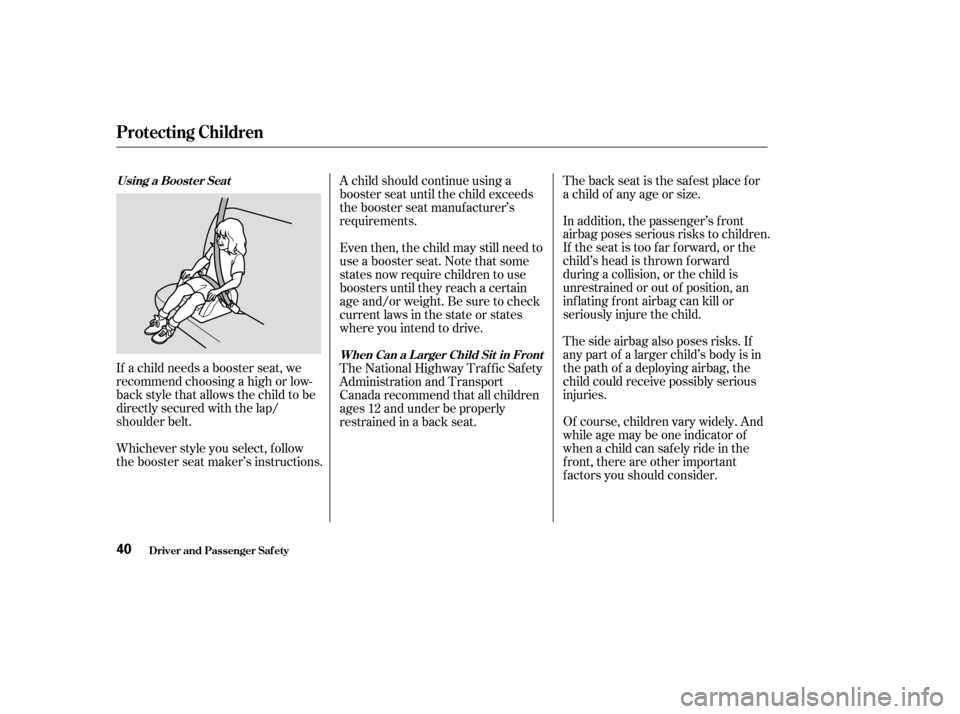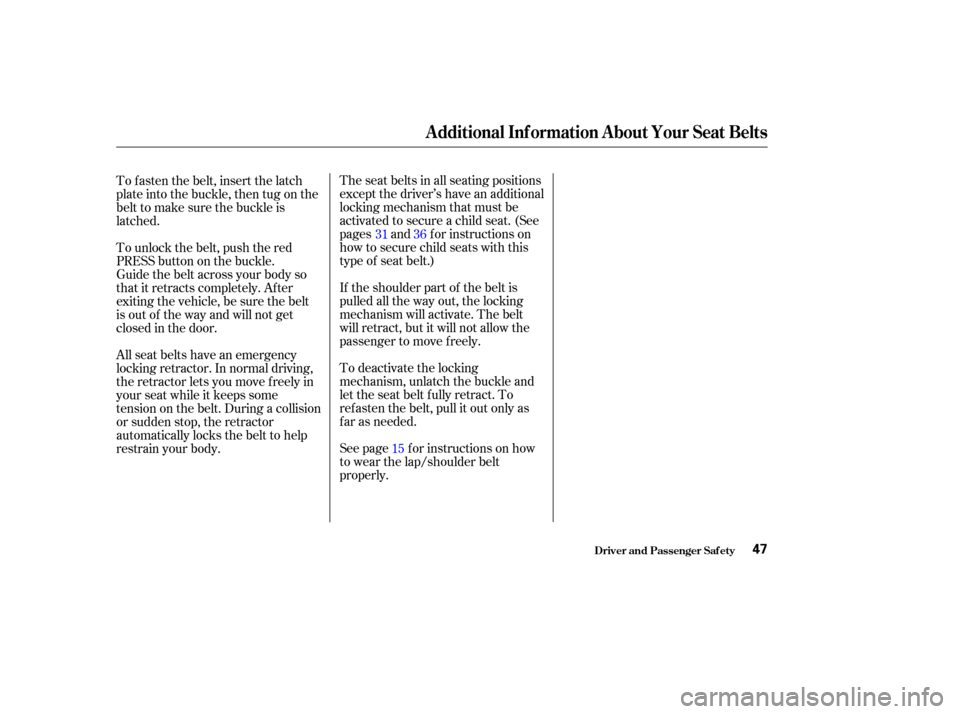Page 40 of 392

The lap/shoulder belts in the outer
back and f ront passenger seating
positions have a locking mechanism
that must be activated to secure a
child seat.
The f ollowing pages provide
instructions on how to secure a
f orward-f acing child seat with this
type of seat belt.With the child seat in the desired
seating position, route the belt
through the child seat according
to the seat maker’s instructions,
then insert the latch plate into the
buckle.
If you have a child seat designed
to attach to the vehicle’s
LATCH anchorage system,
f ollow the instructions on page
.
If it is necessary to put a f orward-
f acing child seat in the f ront, move
the vehicle seat as far to the rear as
possible, be sure the child seat is
f irmly secured to the vehicle, and the
child is properly strapped in the seat.
Bef ore installing a child seat in the
center seat of the second row or
one of the third row seats, make
sure the seat belt detachable
anchor is latched (see page ).
1. 2.
44
97
Inst alling a Child Seat wit h a L ap/Shoulder Belt
Protecting Children
Driver and Passenger Saf ety36
Improperly placing a forward-
facing child seat in the front
seat can result in serious injury
or death if the front airbags
inflate.
Ifyoumustplaceaforward-
facing child seat in front, move
the vehicle seat as far back as
possible and properly restrain
the child.
Page 41 of 392

Push and pull the child seat
f orward and f rom side to side to
verif y that it is secure enough to
stay upright during normal driving
maneuvers. If the child seat is not
secure, unlatch the belt, allow it to
retract f ully, then repeat these
steps.
Af ter conf irming that the belt is
locked, grab the shoulder part of
the belt near the buckle and pull
up to remove any slack from the
lap part of the belt. Remember, if
the lap part of the belt is not tight,
the child seat will not be secure. It
mayhelptoputweightonthe
child seat, or push on the back of
the seat, while pulling up on the
belt.
To activate the lockable retractor,
slowly pull the shoulder part of the
belt all the way out until it stops,
then let the belt f eed back into the
retractor (you might hear a
clicking noise as the belt retracts).
Af ter the belt has retracted, tug on
it. If the belt is locked, you will not
be able to pull it out. If you can pull
the belt out, it is not locked and
you will need to repeat these steps.
3.
4.
5.
6.
CONT INUED
Protecting Children
Driver and Passenger Saf ety37
Page 44 of 392

Of course, children vary widely. And
while age may be one indicator of
when a child can saf ely ride in the
f ront, there are other important
f actors you should consider.
Whichever style you select, f ollow
the booster seat maker’s instructions. The back seat is the safest place for
a child of any age or size.
In addition, the passenger’s f ront
airbag poses serious risks to children.
If the seat is too f ar f orward, or the
child’s head is thrown f orward
during a collision, or the child is
unrestrained or out of position, an
inf lating f ront airbag can kill or
seriously injure the child.
The side airbag also poses risks. If
any part of a larger child’s body is in
the path of a deploying airbag, the
child could receive possibly serious
injuries.
If a child needs a booster seat, we
recommend choosing a high or low-
back style that allows the child to be
directly secured with the lap/
shoulder belt. A child should continue using a
booster seat until the child exceeds
the booster seat manufacturer’s
requirements.
Even then, the child may still need to
use a booster seat. Note that some
states now require children to use
boosters until they reach a certain
ageand/orweight.Besuretocheck
current laws in the state or states
where you intend to drive.
The National Highway Traffic Safety
Administration and Transport
Canada recommend that all children
ages 12 and under be properly
restrained in a back seat.
Using a Boost er Seat
When Can a Larger Child Sit in Front
Protecting Children
Driver and Passenger Saf ety40
Page 45 of 392

If you decide that a child can saf ely
ride up f ront, be sure to:Caref ully read the owner’s manual
and make sure you understand all
seat belt instructions and all saf ety
inf ormation.
Move the vehicle seat to the rear-
most position.
Have the child sit up straight, back
against the seat, and feet on or
near the f loor.
Check that the child’s seat belt is
properly positioned and secured.
Physically, a child must be large
enough f or the lap/shoulder belt to
properly f it over the hips, chest, and
shoulder (see pages and ). If
the seat belt does not f it properly,
the child should not sit in the f ront.
To saf ely ride in f ront, a child must
be able to f ollow the rules, including
sitting properly and wearing the seat
belt properly throughout a ride.
Supervise the child. Even mature
children sometimes need to be
reminded to f asten the seat belts
or sit properly. Remind the child not to lean
toward the door because of the
side airbag.
15 39Physical Size
Maturity
Protecting Children
Driver and Passenger Saf ety41
Page 46 of 392
Your vehicle has attachment points
for a tether-style child seat to be
installed on the second or third row
as shown.
Since a tether can provide additional
security, we recommend using a
tether whenever one is required or
available.Each second row seat has a tether
anchorage point behind the seat
back.There are three anchorage points on
the tailgate sill. Select the anchorage
point you want to use, and slide the
cover to open it (outboard anchor),
or remove the cover (center anchor).
Second Seat Installation:
Third Seat Installation:Using Child Seats with T ethers
Protecting Children
Driver and Passenger Saf ety42
TETHER ANCHORAGE POINT
Page 48 of 392
Put the child seat in a second row
vehicle seat and attach the child
seat to the lower anchors
according to the child seat maker’s
instructions.
Your vehicle is equipped with
LATCH (Lower Anchors and
Tethers f or Children) at the second
row seats. The lower anchors are
located between the seat-back and
seat bottom and are to be used only
with a child seat designed f or use
with LATCH. The exact location of each lower
anchorage is marked with a small
circle above the lower anchorage
point.
Move the seat belt buckle or seat
belt tongue away f rom the lower
anchors.
To install a LATCH-compatible child
seat:
Make sure there are no f oreign
objects around the anchors.
Foreign objects could get in the
way of a secure connection
between the child seat and the
anchors.
1.
2.
3.
Using L A T CH
Protecting Children
Driver and Passenger Saf ety44
LOWER
ANCHORS
RIGID TYPE
MARKS
Page 49 of 392
Follow the child seat maker’s
instructions f or any additional
advice on adjusting or tightening
the fit.Attach the attaching clip to the
tether anchor fitting and tighten
the strap according to the child
seat maker’s instructions. Make
sure the strap is not twisted.
Push and pull the child seat
f orward and f rom side to side to
verif y that it is secure enough to
stay upright during normal driving
maneuvers.This symbol on rear or f orward
f acing child seats or booster
cushions indicates the presence of
LATCH compatible hardware.
4.
5.
6.
Protecting Children
Driver and Passenger Saf ety
L ower Universal Anchorage
System Symbol
45
FLEXIBLE TYPE
Page 51 of 392

The seat belts in all seating positions
except the driver’s have an additional
locking mechanism that must be
activated to secure a child seat. (See
pages and f or instructions on
how to secure child seats with this
type of seat belt.)
If the shoulder part of the belt is
pulled all the way out, the locking
mechanism will activate. The belt
will retract, but it will not allow the
passenger to move f reely.
To deactivate the locking
mechanism, unlatch the buckle and
let the seat belt f ully retract. To
ref asten the belt, pull it out only as
f ar as needed.
See page f or instructions on how
to wear the lap/shoulder belt
properly.
To fasten the belt, insert the latch
plate into the buckle, then tug on the
belt to make sure the buckle is
latched.
To unlock the belt, push the red
PRESSbuttononthebuckle.
Guide the belt across your body so
that it retracts completely. After
exiting the vehicle, be sure the belt
is out of the way and will not get
closed in the door.
All seat belts have an emergency
locking retractor. In normal driving,
the retractor lets you move f reely in
your seat while it keeps some
tension on the belt. During a collision
or sudden stop, the retractor
automatically locks the belt to help
restrain your body.
15
31 36
Additional Inf ormation About Your Seat Belts
Driver and Passenger Saf ety47